Shaun Livingston serves as symbol for Warriors’ culture

Four points were all that separated the Warriors from ignominy. The most accomplished regular season team in NBA history had played the Thunder to such a shortfall in the Western Conference finals that Game 5 could have been their last. All that remained were elimination games, fraught with risk and insecurity for a team that would fail itself with anything less than an NBA title. Golden State had been pushed to its limit—first with a loss at home, then with blowout defeats on the road, and ultimately leading into a decisive final quarter in which their four-point lead felt anything but secure. In this most desperate hour, Warriors coach Steve Kerr trusted Shaun Livingston.
Starting the fourth is standard for Livingston, who buys Stephen Curry precious rest as Golden State’s backup point guard. He began this stint with a pick-and-roll, triggering a switch in the process to line up Thunder center Steven Adams as his on-ball defender. Though Adams is long and nimble, Livingston stuttered his way into a successful pull-up jumper at the free throw line. On the following possession, Livingston was picked off by Adams while defending Dion Waiters’s live dribble. He played up and over the contact—looping back around to deny Waiters access to the lane. Somehow, Livingston recovers with perfect balance. Waiters attempts to lunge past him but gets nowhere, only to then kill his dribble for a futile shot fake. Livingston remains planted, his arms blanketing Waiters until the rising tension—courtesy of a dwindling shot clock and a mounting three-second count—leads to a panicked turnover. That defensive stand gets the Warriors out on the break and into an open three-pointer for Andre Iguodala. It falls.
Does Steph Curry's defense warrant Russell Westbrook's laughter?
In time, Livingston would go on to find Barnes for a trailing three, back down Waiters for a turnaround jumper, and pass his way out of the post to get Marreese Speights to the free throw line. By the time he left the floor with 7:55 remaining, the Warriors lead had grown to 12—eight points better than he found it. Livingston retired for the night as the quiet co-author of one of the game’s most critical stretches, composed without the aid of his All-NBA teammates.
Livingston exists in negative space. While the thrill of watching the Warriors comes from players like Curry and Klay Thompson, Livingston is—almost by definition—the marker of their absence. He fills in at the point alongside Thompson, on the wing alongside Curry, or at the helm alongside neither. His minutes fill the void of the Warriors’ needs, in part because his game grows to complement whichever teammates are on the floor.
“I’m a cerebral player,” Livingston said. “Once I slide to the shooting guard or small forward, I'm a little bit more nontraditional as I don't space the floor. So I find other ways to stay occupied and attack and cut, offensive rebound, set screens. It's just part of being a basketball player. It's not necessarily what you have to do when you're playing playing the shooting guard, playing the small forward. It's the game of basketball. Be a basketball player. It comes with many roles. How can you help your team win? For me, it just depends on the personnel that's out there.”
That kind of positional fluidity is, in part, a function of Livingston’s size. No other point guard in the league would be deliberately cross-matched to defend Kevin Durant. Few could switch comfortably on to opposing bigs without being overwhelmed inside. Livingston, who stands 6'7" with a 6'11" wingspan, holds his own in both regards. The breadth of his defensive skill set and knowledge makes him a chess piece player for the Warriors—a defender who can be moved all around the the floor to manipulate matchups of almost any kind. Between Iguodala, Thompson, and Livingston lies a wealth of defensive ability and the freedom for a coaching staff to make proactive strategic choices.
• MORE NBA: How long before KD, OKC reign? | The book on Roberson
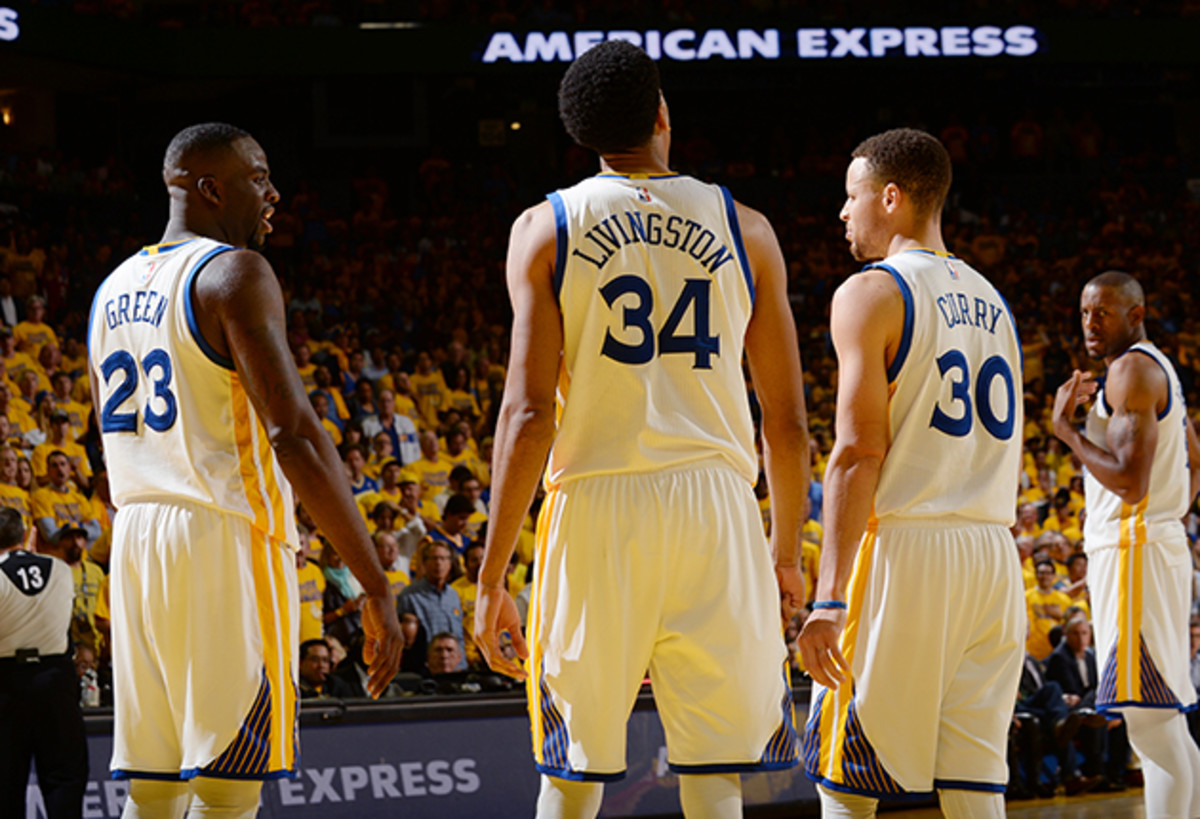
In navigating those assignments, Livingston subtly tailors his approach in real time to a wide variety of opponents. He credits his mind for scouting to Mike Dunleavy Sr.—Livingston’s first head coach in the NBA and a meticulous game planner. It was Dunleavy who really pushed Livingston to see his assignments for the unique opportunities they presented. Then he was defending point guards for the Clippers almost exclusively in a traditional scheme. These days, Livingston grapples with the tendencies of the opponent’s entire rotation, knowing full well he could be switched to cover any player at any time.
“It's just a feel,” Livingston said. “It’s just a feel for the game and knowing who you're playing. It's tough—sometimes it's read and react. Sometimes it can move a little bit too fast for you. But I learned a lot from [Dunleavy], learned a lot from personnel and what you wanted to make guys do on the court and how to play to their weaknesses. I think that helped me.”
It’s fitting that Livingston became a sort of incidental symbol for the Warriors’ organizational culture. Kerr and general manager Bob Myers made a joint phone call to learn more about Livingston in the summer of 2014, per Kevin Arnovitz of ESPN.com, when Golden State was considering the guard as a free agent addition. The notes regarding Livingston that Kerr sketched out on the whiteboard in Myers’s office remain to this day—a symbol of the kind of spirited, cooperative discussion and information gathering that define the Warriors’ process. Livingston works just the same as a model for the sort of players Golden State has staked its franchise around: those flexible enough to play a variety of roles, selfless enough to accept whichever is best for the team, and intelligent enough to maximize those opportunities.
All three of those qualities intersect when Livingston plays off the ball. Some point guards in the league—and those who play backup minutes, in particular—are insistent on control; they bring the ball upcourt, look to initiate offense, and attempt to make direct scoring plays. Livingston, by contrast, is a disciple of the hit-ahead pass. “You can't out-run the ball,” Livingston said. Rather than handle the offense alone, Livingston will shoot the ball up the floor to an open teammate, even one just slightly ahead of the defense. Golden State’s pace begins with a willingness to let go.
The little-known book that shaped the minds of Steve Kerr and Pete Carroll
“For me, I feel like by advancing the basketball, the defense can't get set and also it creates rhythm,” Livingston said. “It creates flow and it builds trust and confidence with your teammates. When they get the ball, they feel a part of the team. And when you advance the ball, it gives the offense the ability to attack or the ability to make another play, to advance the ball further. It's not always about the assists—sometimes it's the hockey assists.” Only four players this postseason have averaged more hockey assists per minute than Livingston, per NBA.com.
Livingston has done this throughout his career, though the tendency is especially striking when he can advance the ball to any non-center teammate. The payoffs come in layers. Some passes up the floor create an immediate scoring opportunity, while others trigger an opening on the secondary break—say for a trailing shooter. More often, particularly against opponents who defend as well as the Thunder, the value comes from getting the ball up the floor quickly and building immediately into offense. It may take 15 seconds for the Warriors to actually attempt a shot, but that initial pass can force a scramble that leads into a swing pass, setting up a drive and kick into an open three-pointer. The way Oklahoma City has switched screens in the Western Conference finals has muted some of that momentum, though the Warriors were more successful in shedding their defenders through multiple actions in Game 5 than at any point previously in the series.
Doing this is only feasible, however, when a point guard will both give up the ball early and then flow directly into cutting and screening to facilitate the offense. Livingston doesn’t have the ability to space the floor; though the Splash Brothers are a member of his basketball family, Livingston is surely adopted. He compensates by reading plays as they develop and working the angles—skills he’s honed since his days playing alongside Daniel Ruffin at Peoria Central High School.
“Playing year after year, you see what kind of defenses are in the NBA,” Livingston said. “How they're gonna react off the pick-and-roll, off of a pin-down, or a screen, or whatever. You just kinda read. You know that defenses are designed to help. It's not just one on one. Help defense—if a guy gets beat, the next guy steps up. It's just thinking about the play before the play happens.”
SI's Best Photos of Draymond Green
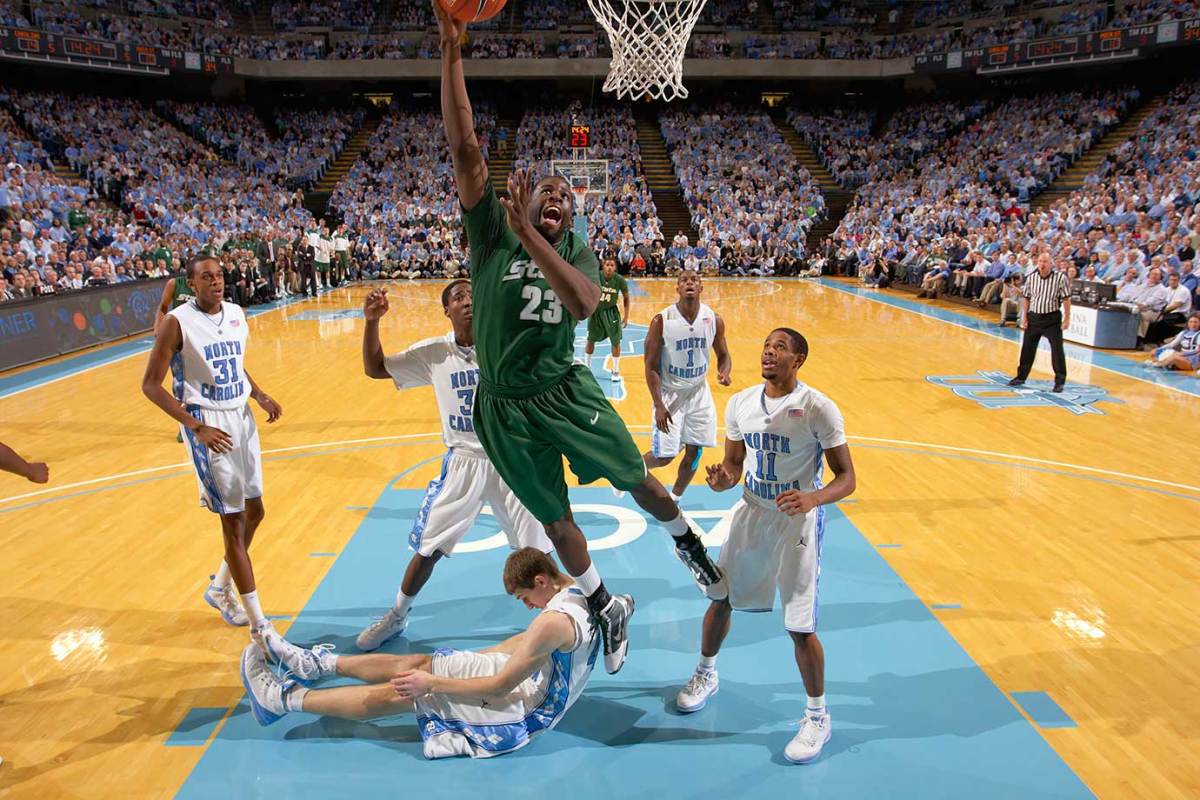
Draymond Green shoots a layup during Michigan State's game against North Carolina on Dec. 1, 2009 at the Dean Smith Center in Chapel Hill, N.C.
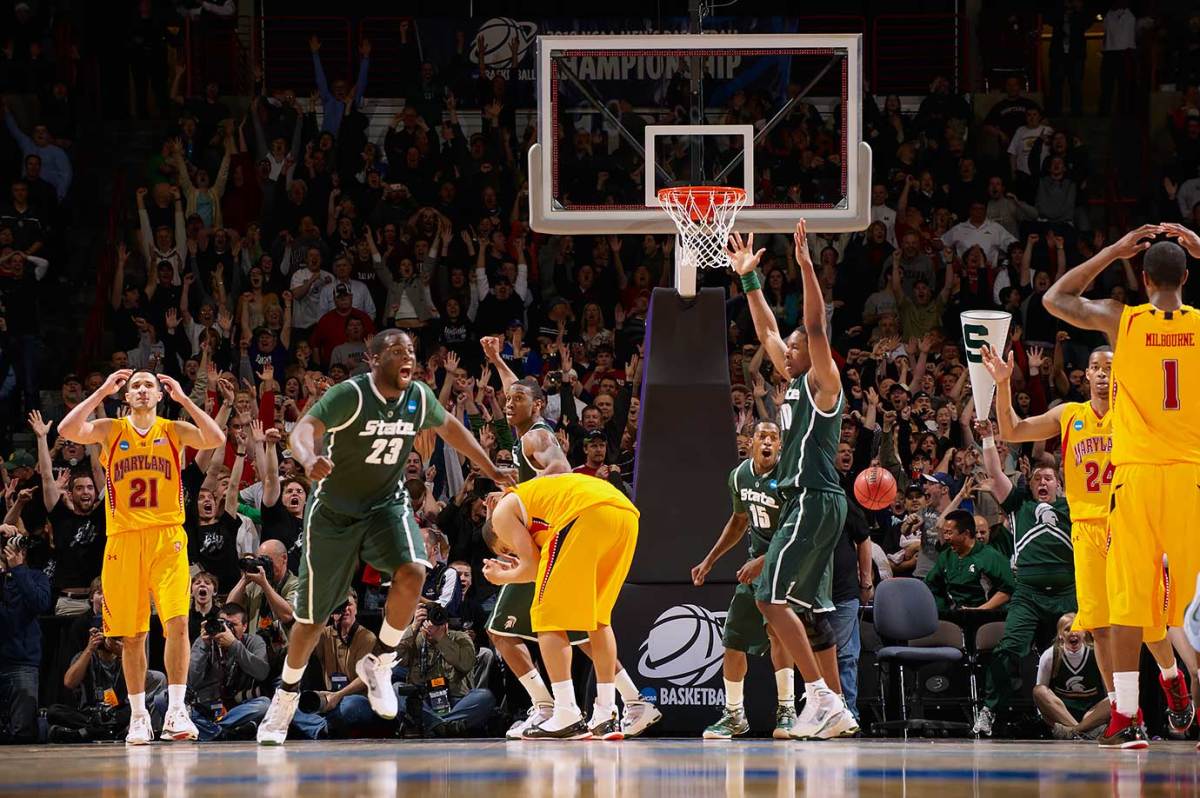
Draymond Green celebrates Michigan State's 85-83 win over Maryland in the second round of the NCAA Tournament on March 21, 2010 at Scottrade Center in St. Louis.
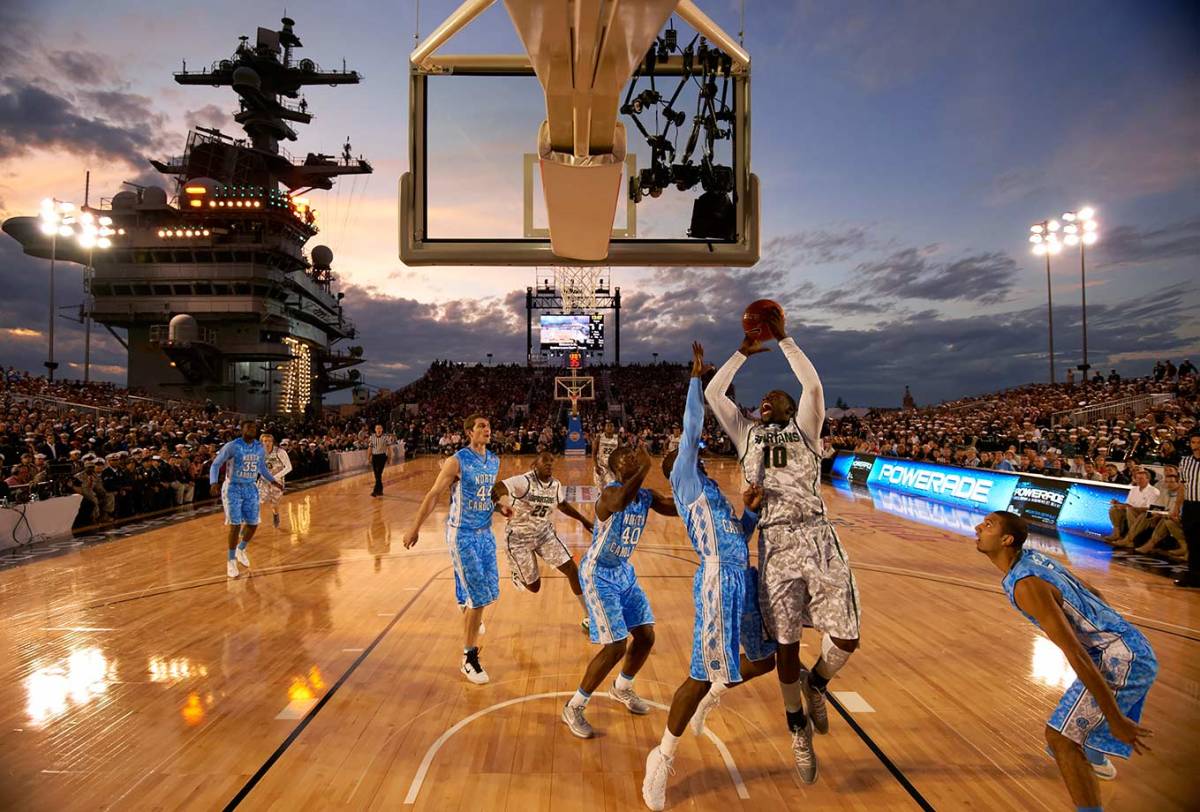
Draymond Green shoots against Leslie McDonald during the Quicken Loans Carrier Classic between Michigan State and North Carolina on Nov. 11, 2011 aboard the USS Carl Vinson in San Diego.
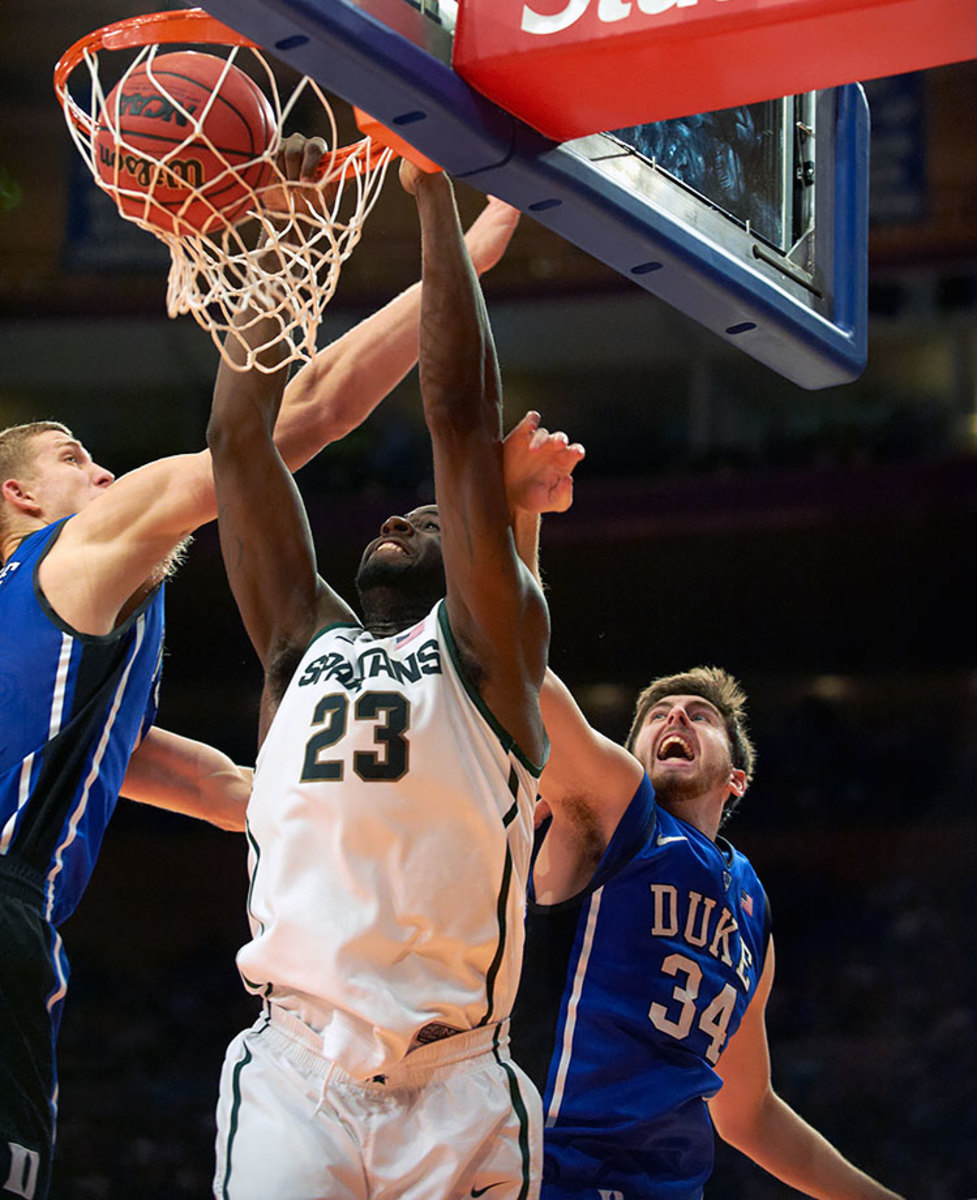
Draymond Green dunks during the State Farm Champions Classic between Michigan State and Duke on Nov. 15, 2011 at Madison Square Garden in New York City.
Draymond Green
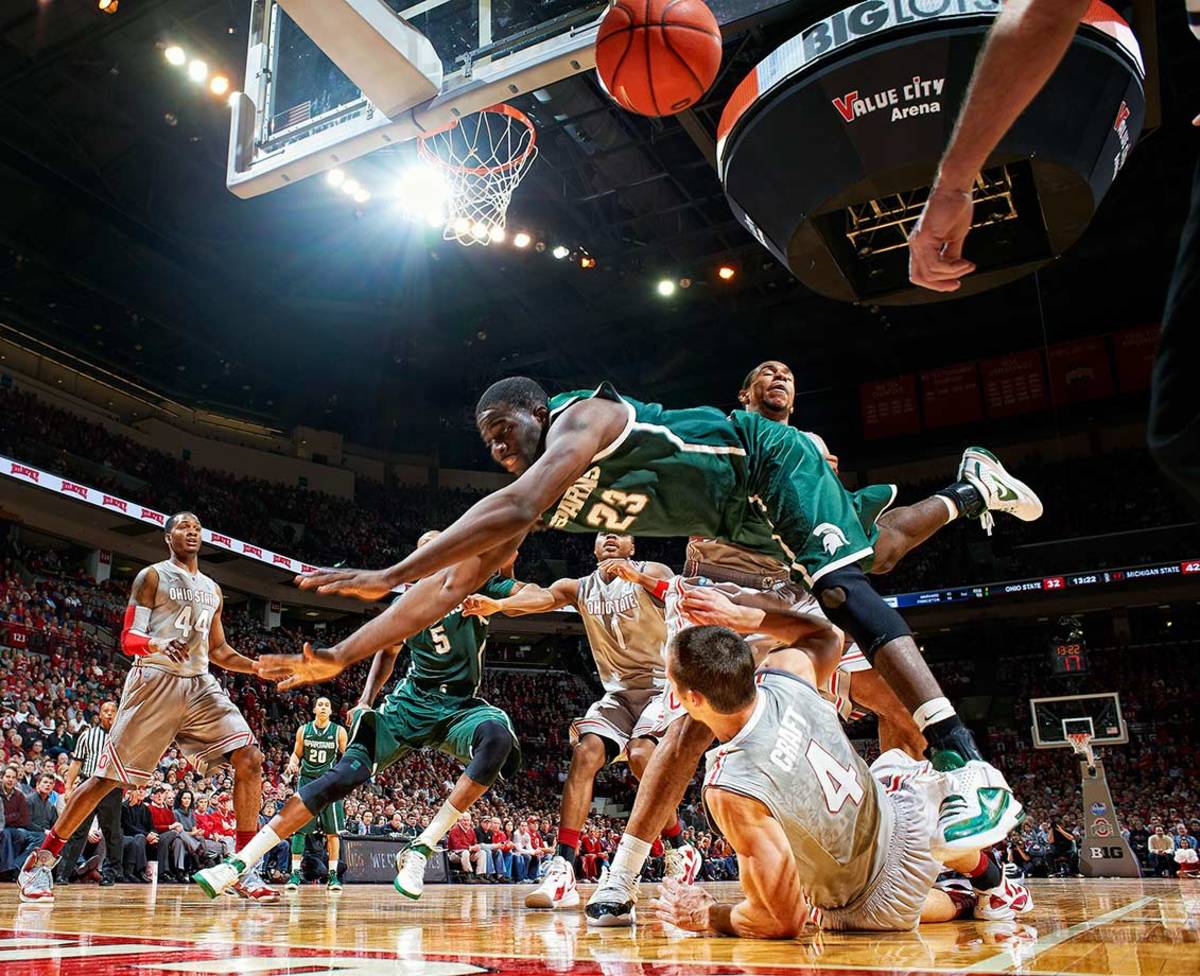
Draymond Green trips over Aaron Craft during Michigan State's game against Ohio State on Feb. 11, 2012 at Value City Arena at Jerome Schottenstein Center in Columbus, Ohio.
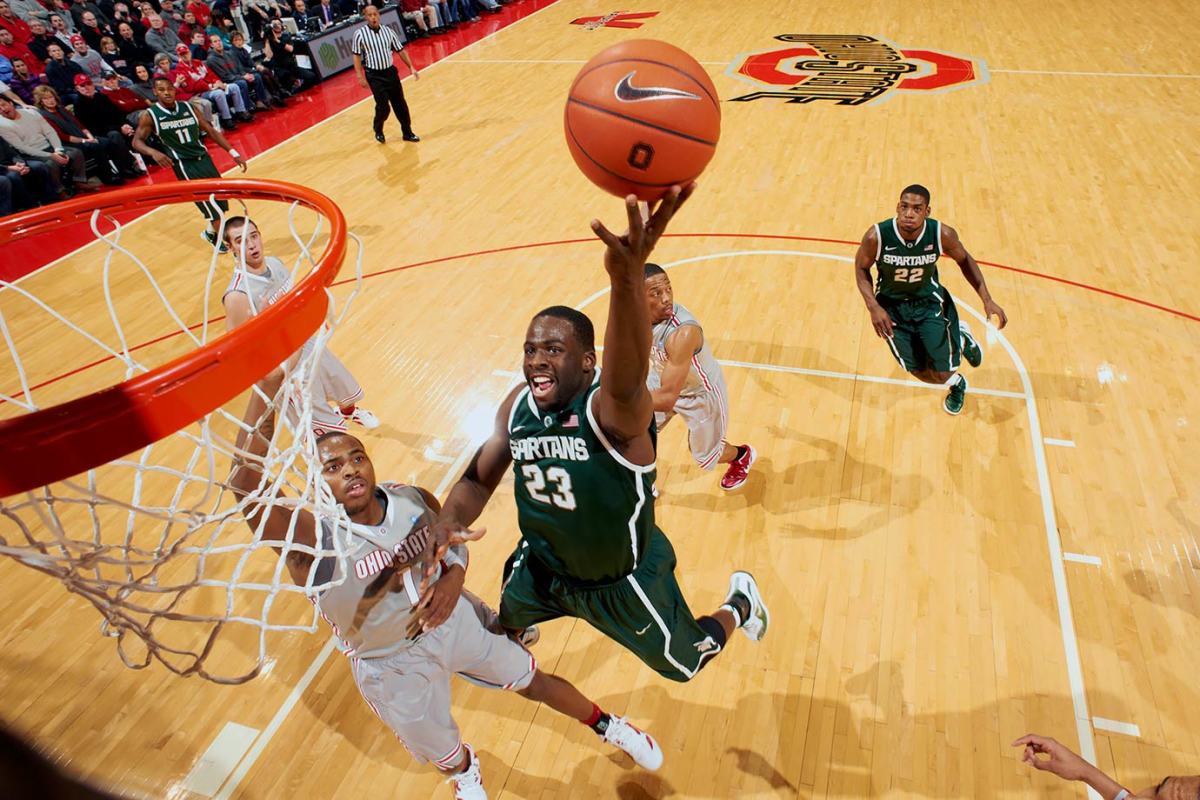
Draymond Green shoots against Deshaun Thomas during the game between Michigan State and Ohio State on Feb. 11, 2012 at Value City Arena at Jerome Schottenstein Center in Columbus, Ohio.
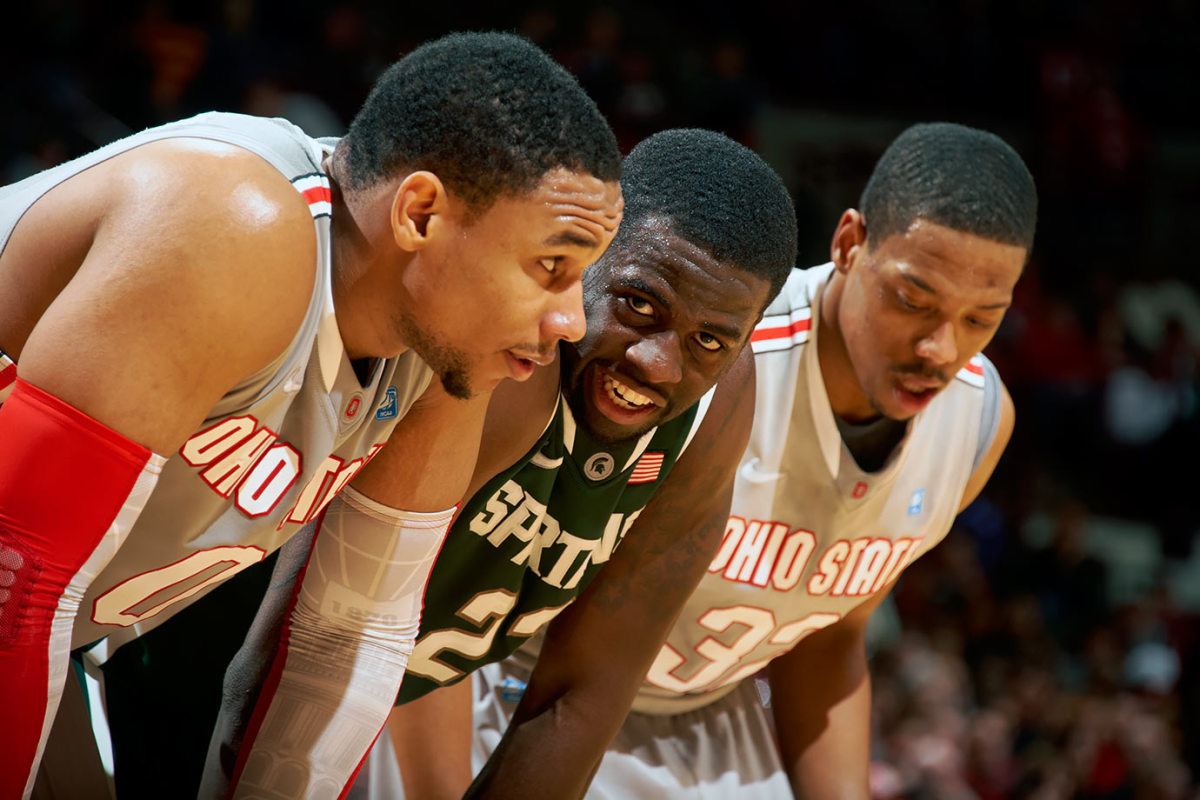
Draymond Green stands alongside Jared Sullinger during Michigan State's game against Ohio State on Feb. 11, 2012 at Value City Arena at Jerome Schottenstein Center in Columbus, Ohio.
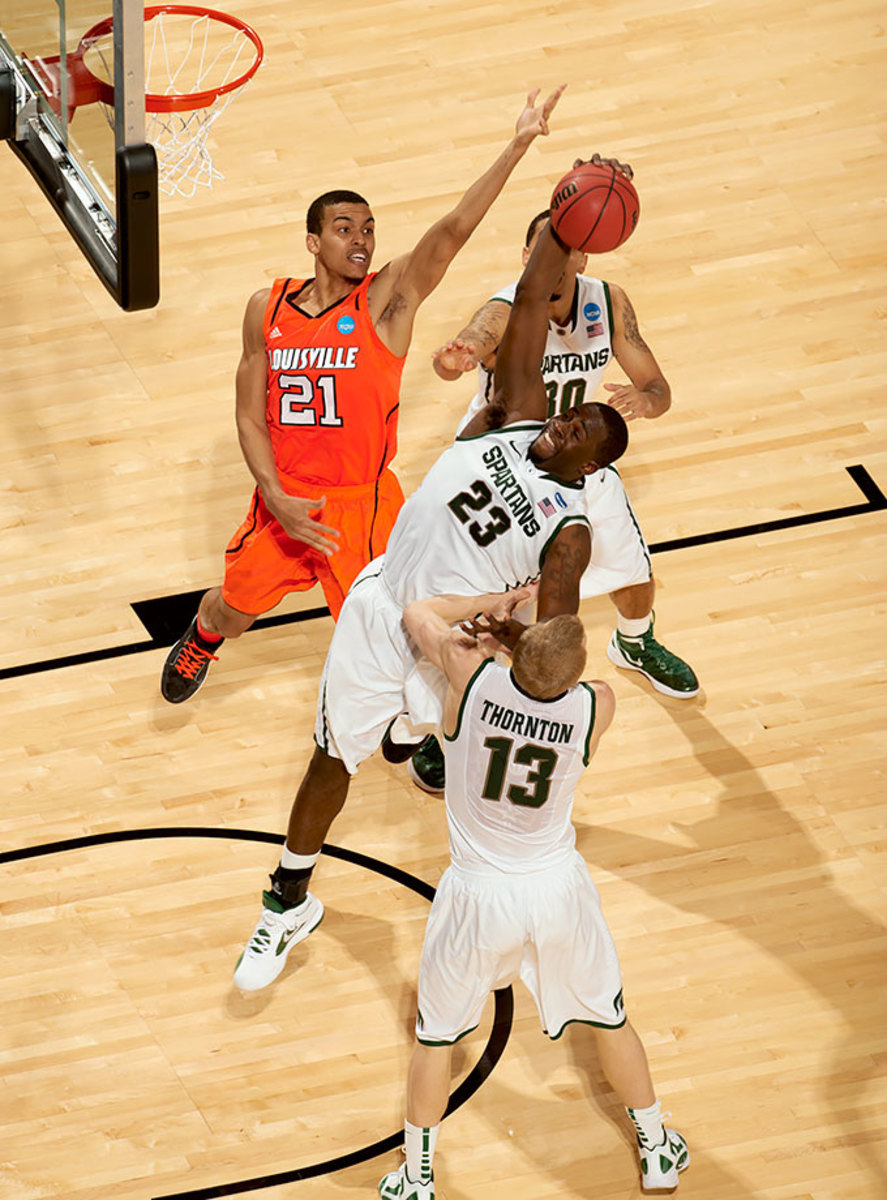
Draymond Green grabs a rebound over Jared Swopshire during the NCAA Tournament Sweet 16 game between Michigan State and Louisville on March 22, 2012 at US Airways Center in Phoenix.
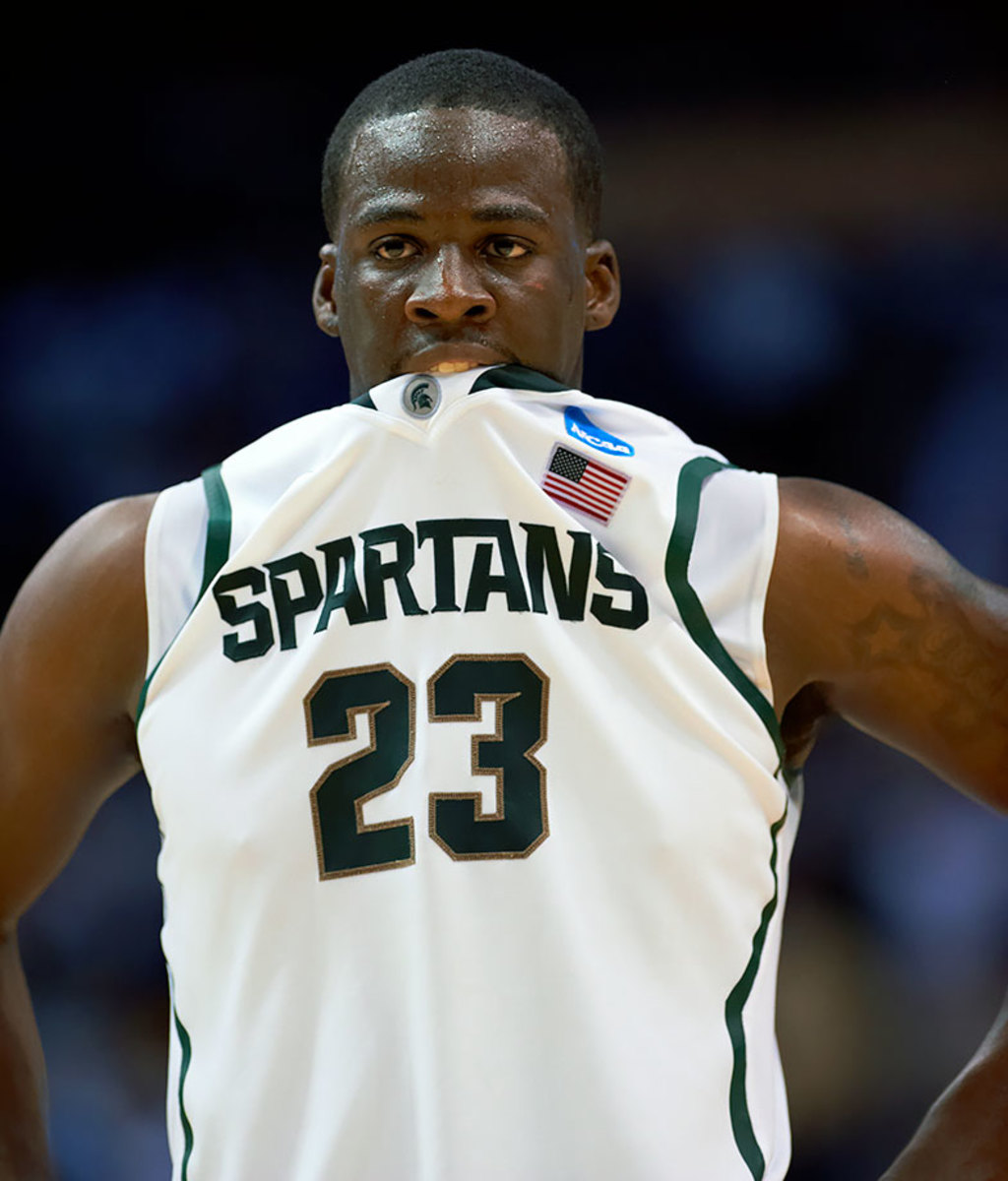
Draymond Green bites his jersey during the NCAA Tournament Sweet 16 game between Michigan State and Louisville on March 22, 2012 at US Airways Center in Phoenix.
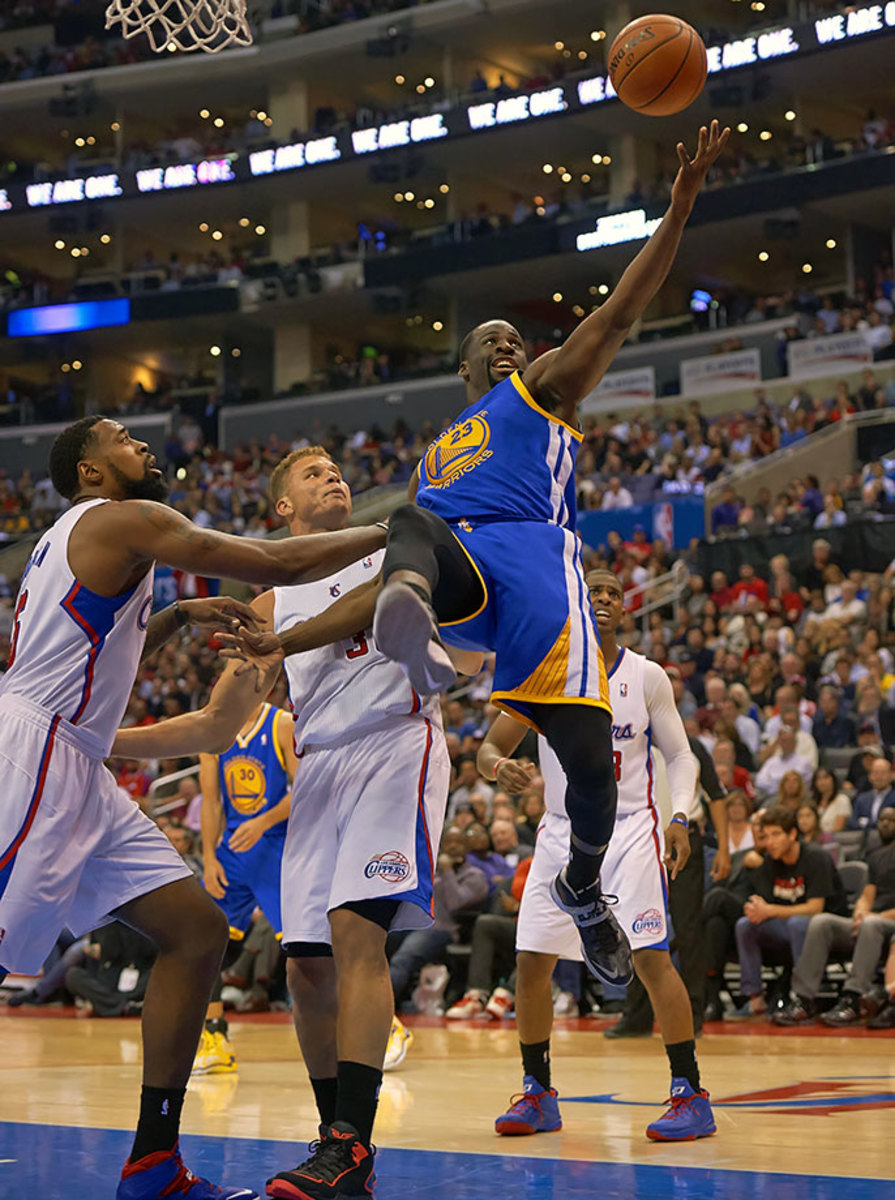
Draymond Green grabs a rebound against Blake Griffin and DeAndre Jordan during Game 5 of the Western Conference First Round between the Golden State Warriors and Los Angeles Clippers on April 29, 2014 at Staples Center in Los Angeles.
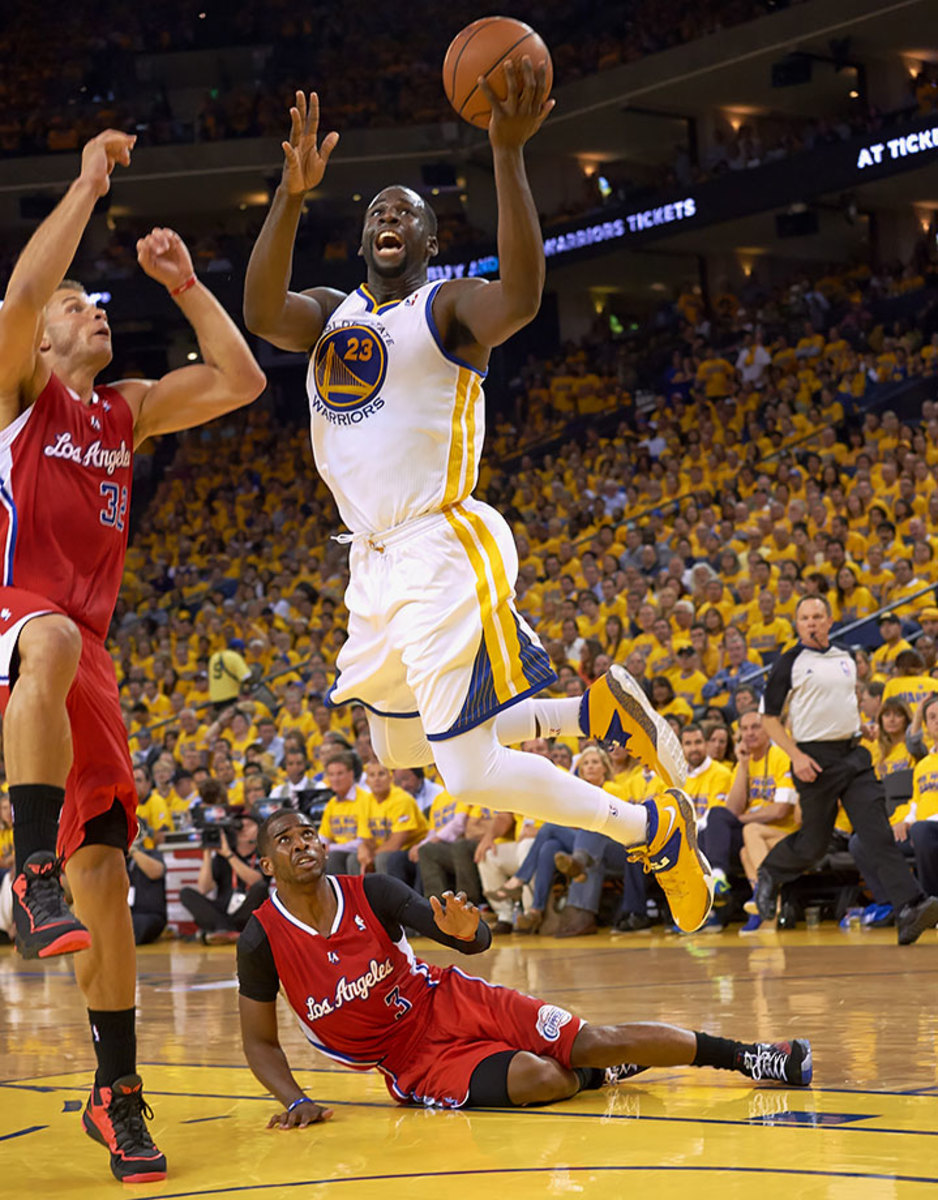
Draymond Green shoots against Blake Griffin and Chris Paul during Game 6 of the Western Conference First Round between the Golden State Warriors and Los Angeles Clippers on May 1, 2014 at Oracle Arena in Oakland.
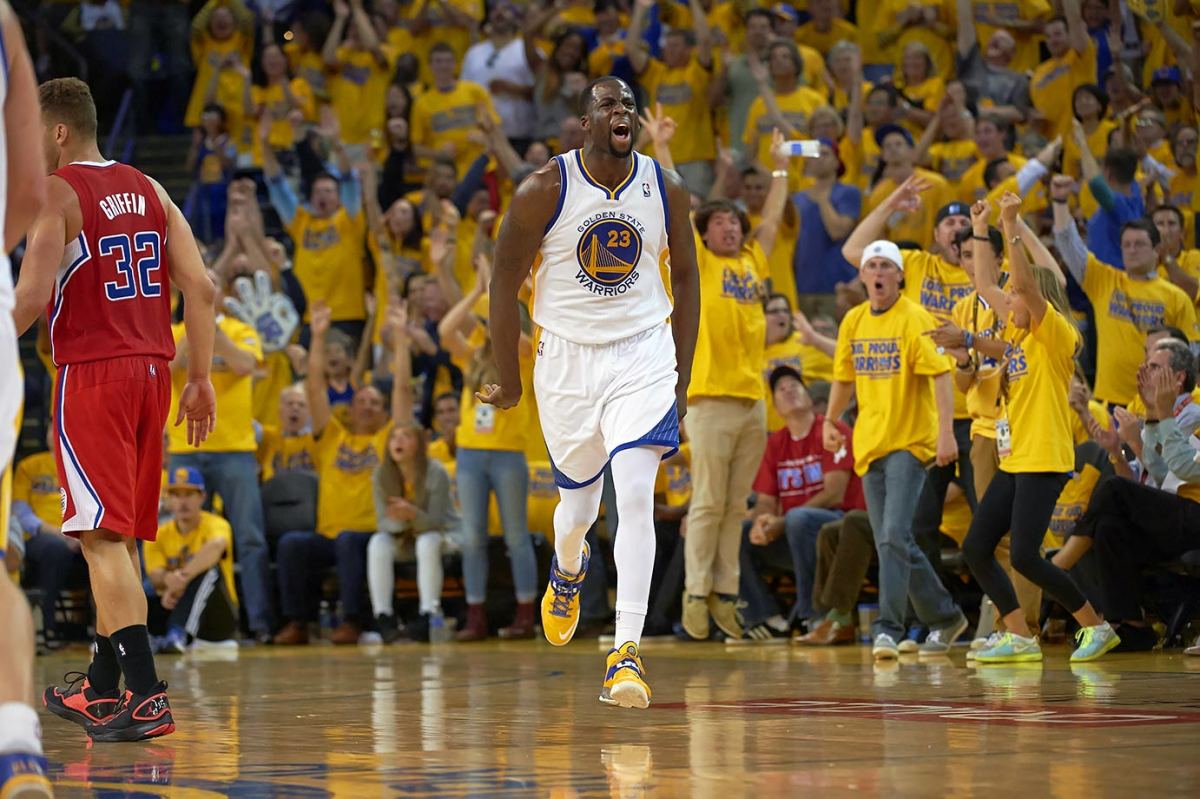
Draymond Green celebrates during Game 6 of the Western Conference First Round between the Golden State Warriors and Los Angeles Clippers on May 1, 2014 at Oracle Arena in Oakland.
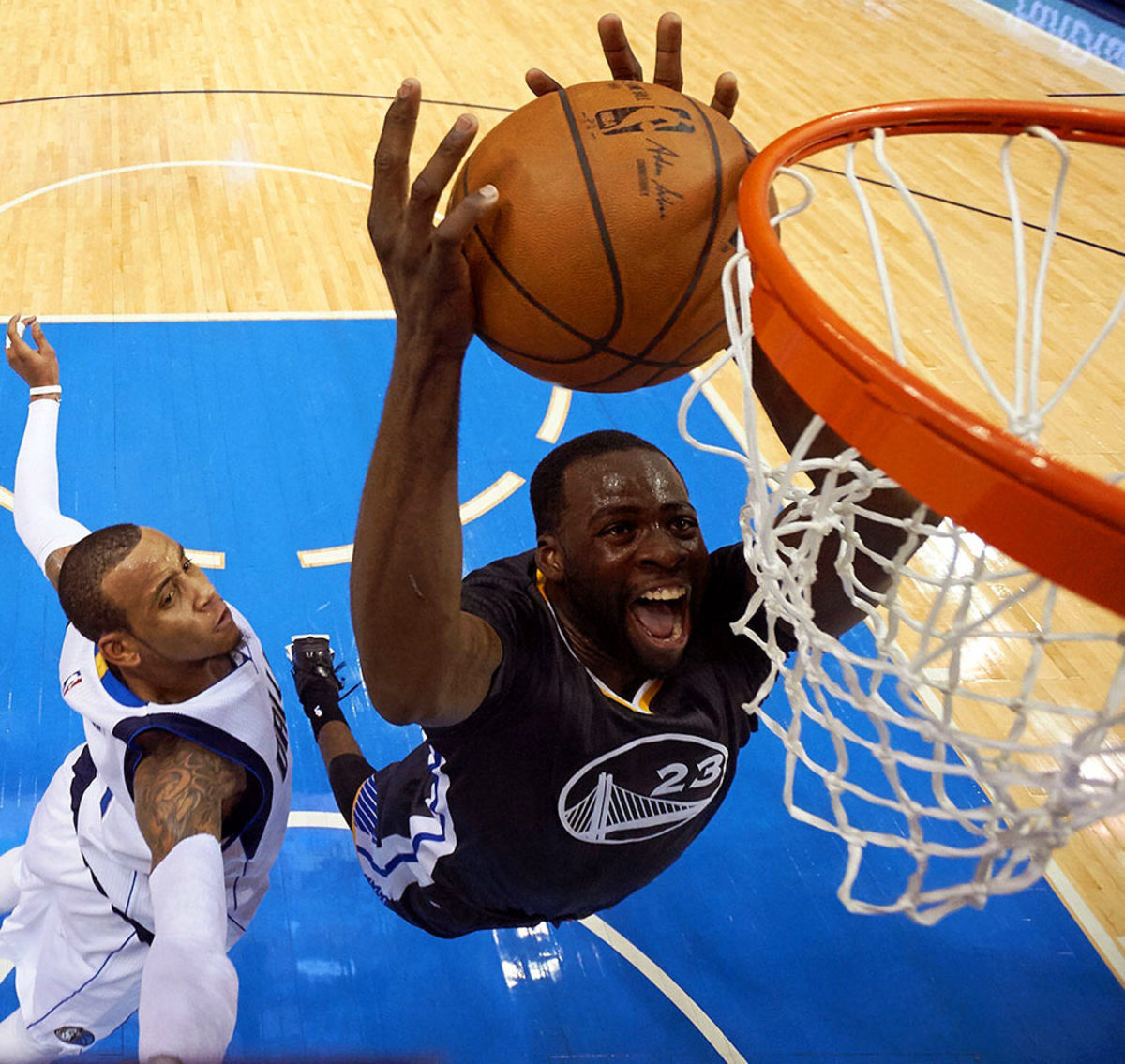
Draymond Green leaps to the basket against Monta Ellis during the game between the Golden State Warriors and Dallas Mavericks on Dec. 13, 2014 at American Airlines Center in Dallas.
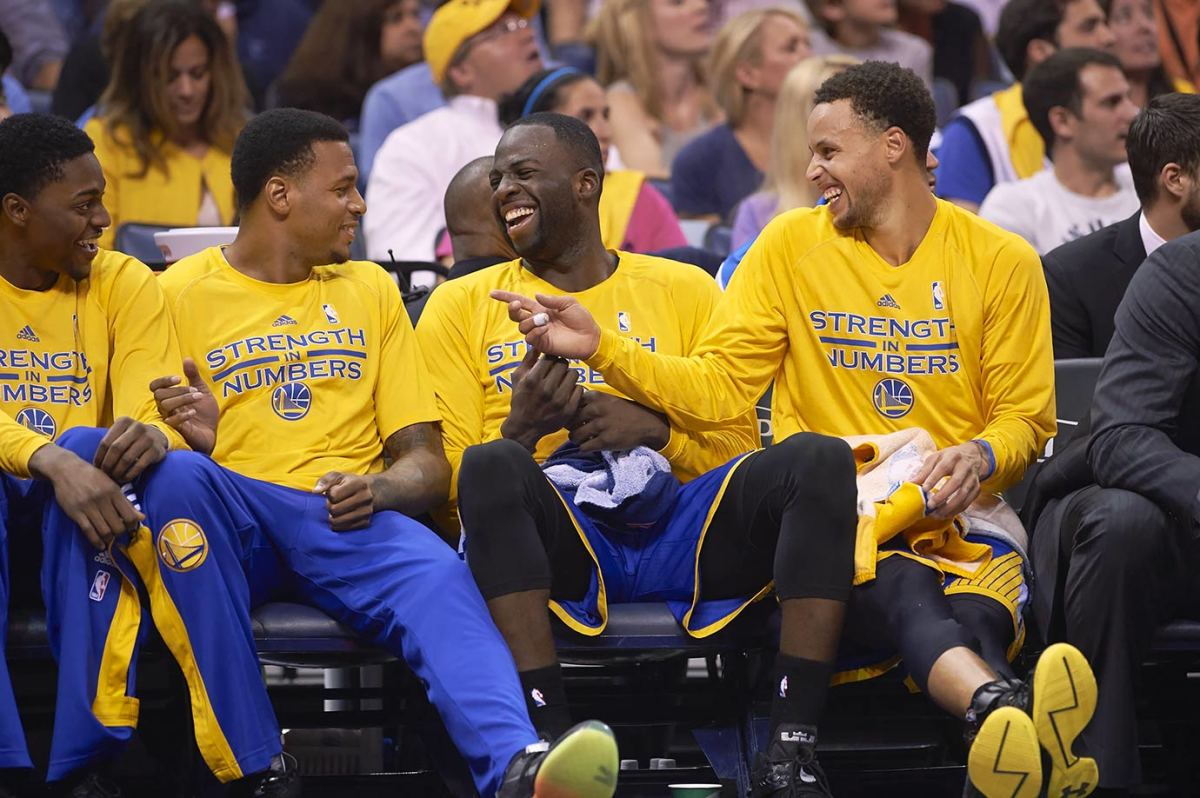
Justin Holiday, Brandon Rush, Draymond Green and Stephen Curry laugh on the bench during Game 6 of the Western Conference Semifinals between the Golden State Warriors and Memphis Grizzlies on May 15, 2015 at FedExForum in Memphis.

Draymond Green walks to the locker room prior to Game 4 of the NBA Finals between the Golden State Warriors and Cleveland Cavaliers on June 11, 2015 at Quicken Loans Arena in Cleveland.
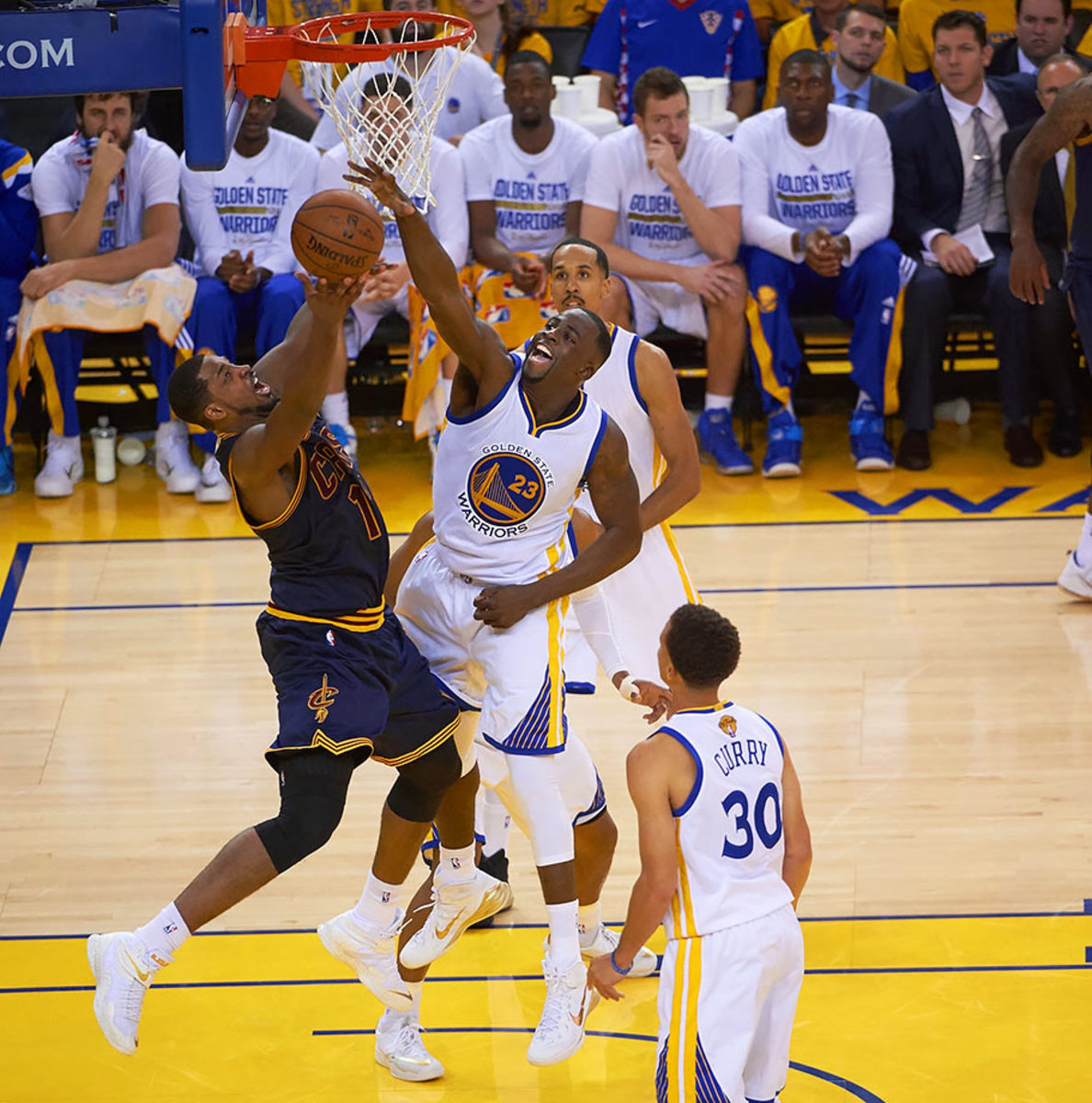
Draymond Green goes up to block Tristan Thompson during Game 5 of the NBA Finals between the Golden State Warriors and Cleveland Cavaliers on June 14, 2015 at Oracle Arena in Oakland.
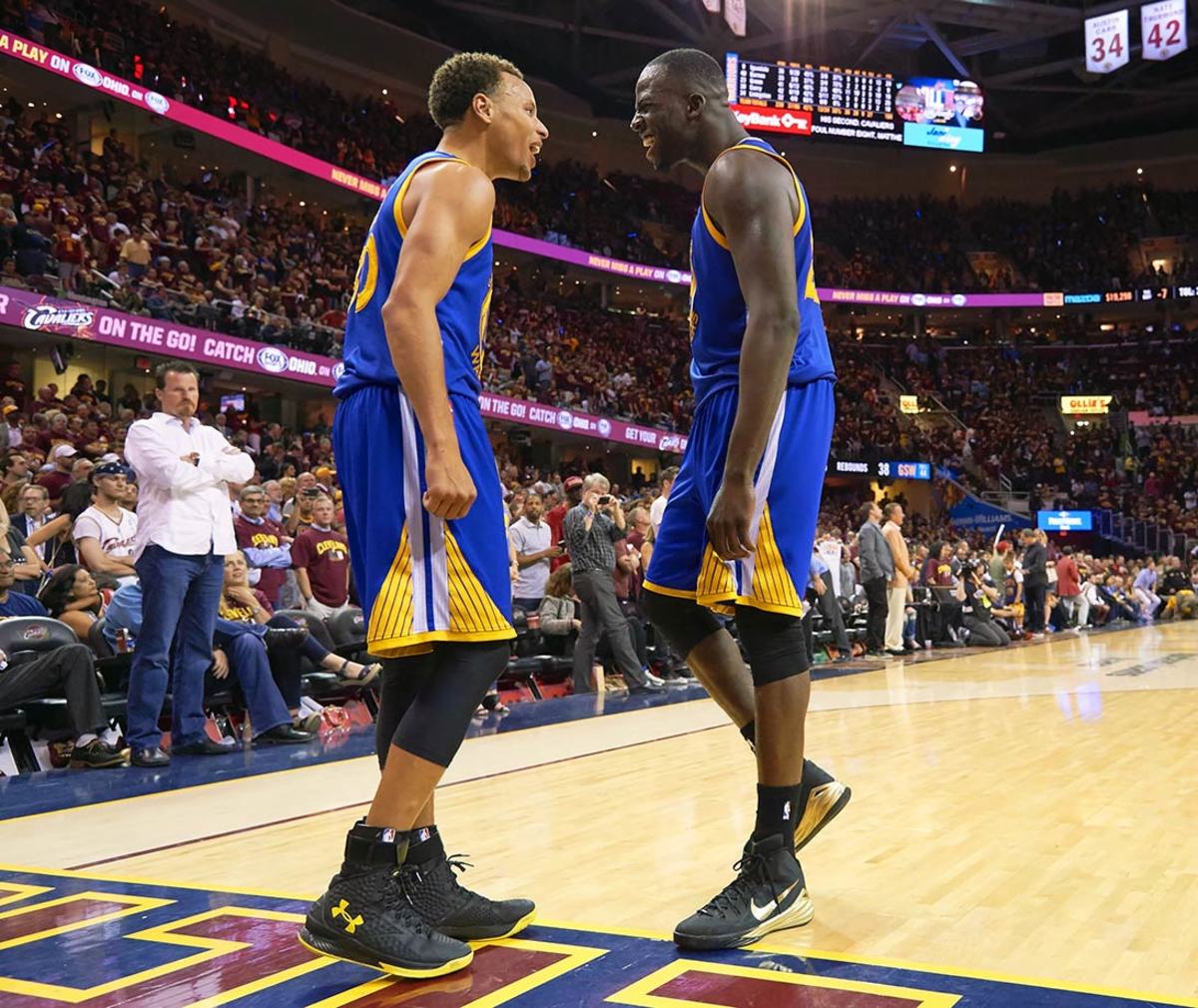
Stephen Curry and Draymond Green celebrate during Game 6 of the NBA Finals between the Golden State Warriors and Cleveland Cavaliers on June 16, 2015 at Quicken Loans Arena in Cleveland.
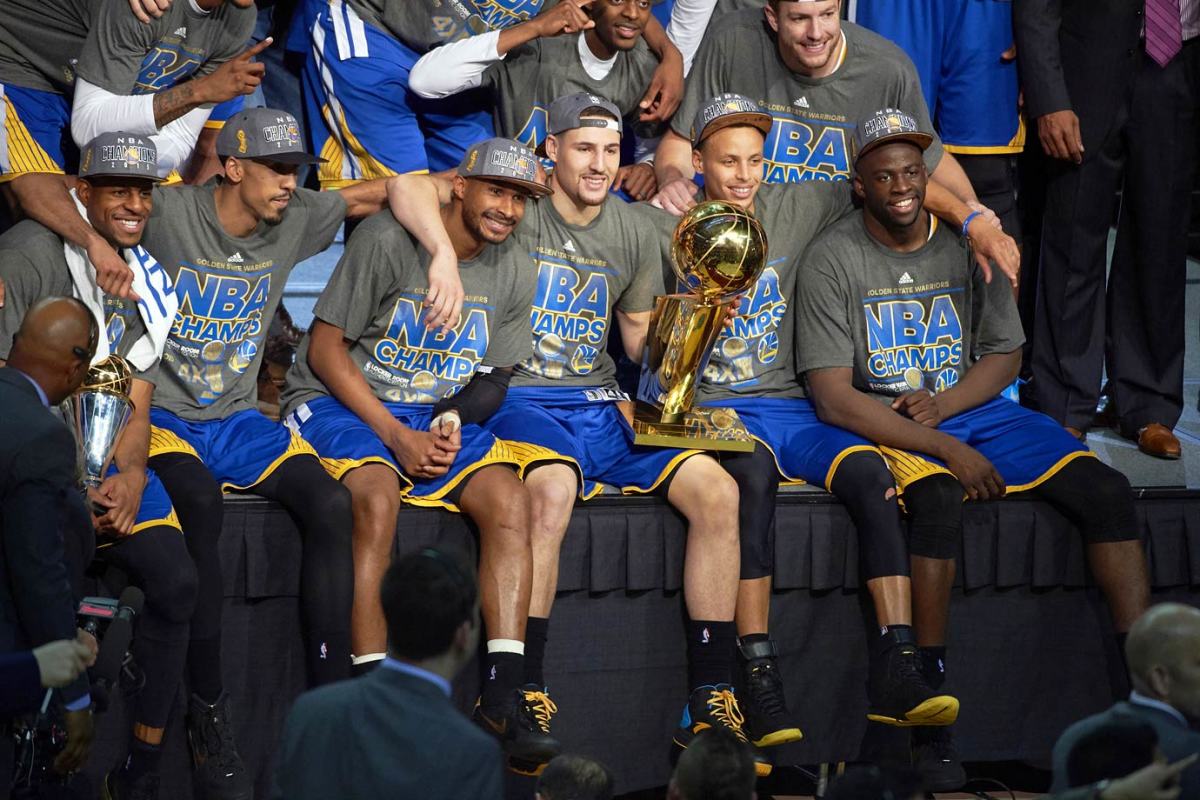
Andre Iguodala, Shaun Livingston, Leandro Barbosa, Klay Thompson, Stephen Curry and Draymond Green celebrate following Game 6 of the NBA Finals between the Golden State Warriors and Cleveland Cavaliers on June 16, 2015 at Quicken Loans Arena in Cleveland.
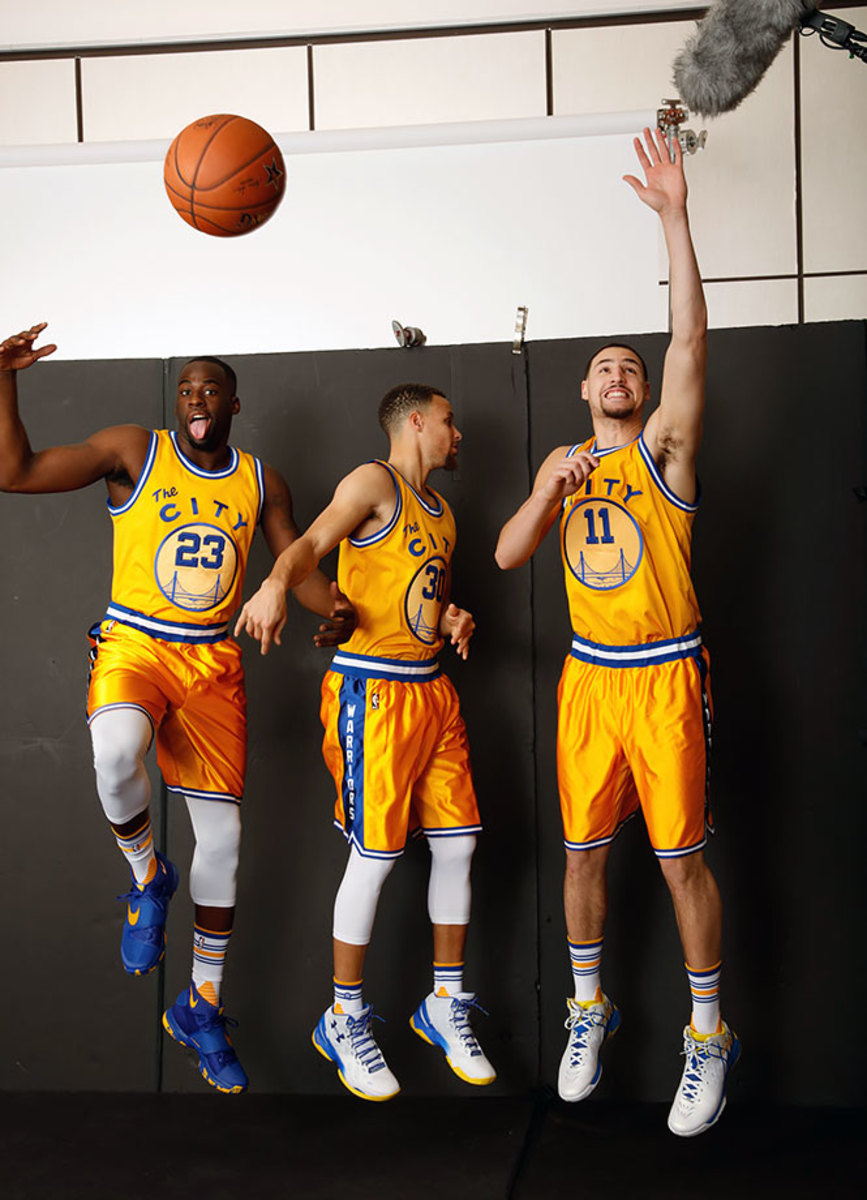
Draymond Green, Stephen Curry and Klay Thompson pose together during their SI cover photo shoot on Feb. 11, 2016 at Sheraton Centre Toronto Hotel.
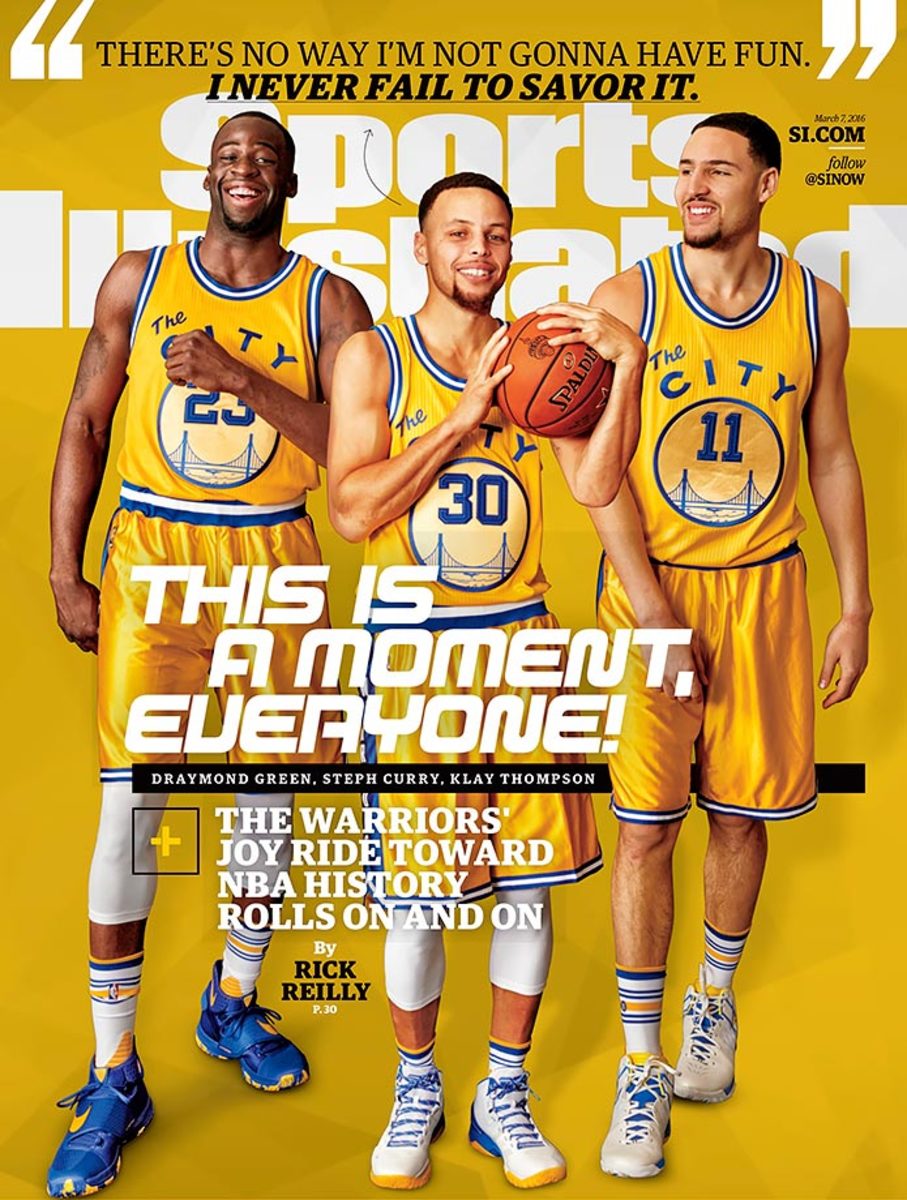
Draymond Green, Stephen Curry and Klay Thompson appear on the March 7, 2016 cover of Sports Illustrated.
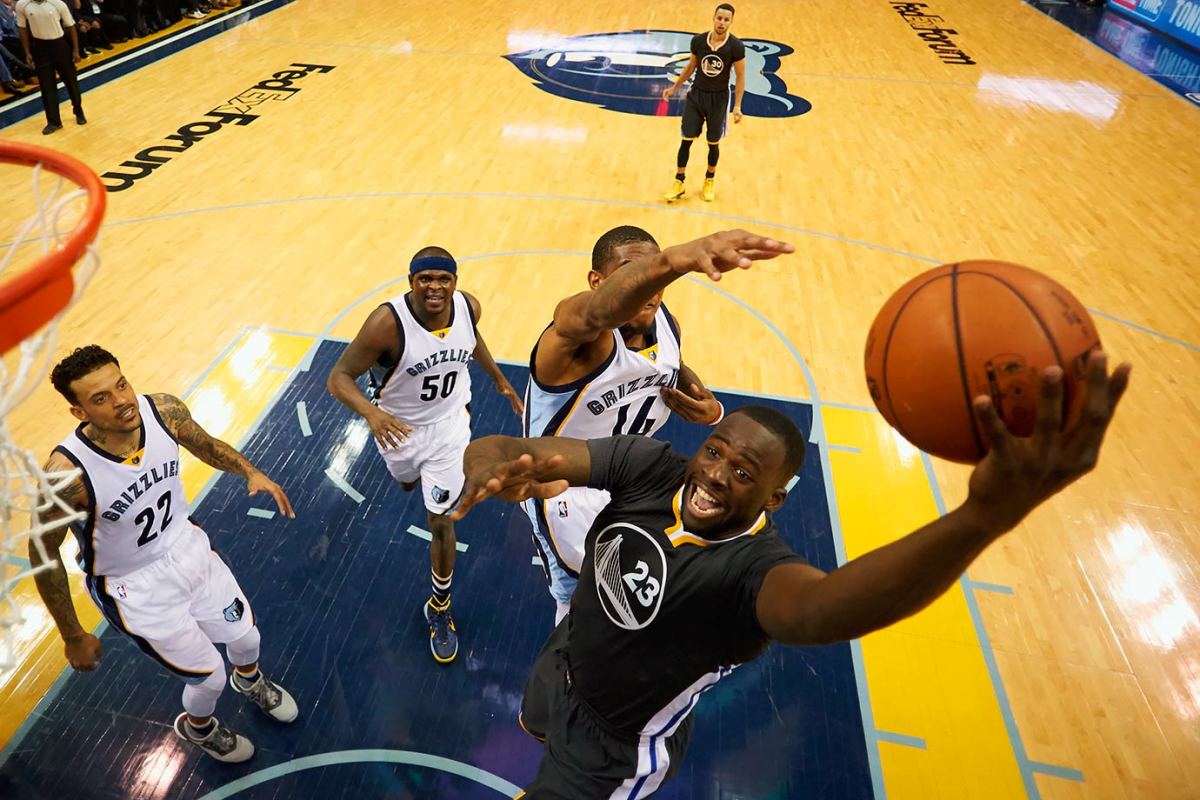
Draymond Green shoots during the Golden State Warriors game against the Memphis Grizzlies on April 9, 2016 at FedExForum in Memphis.
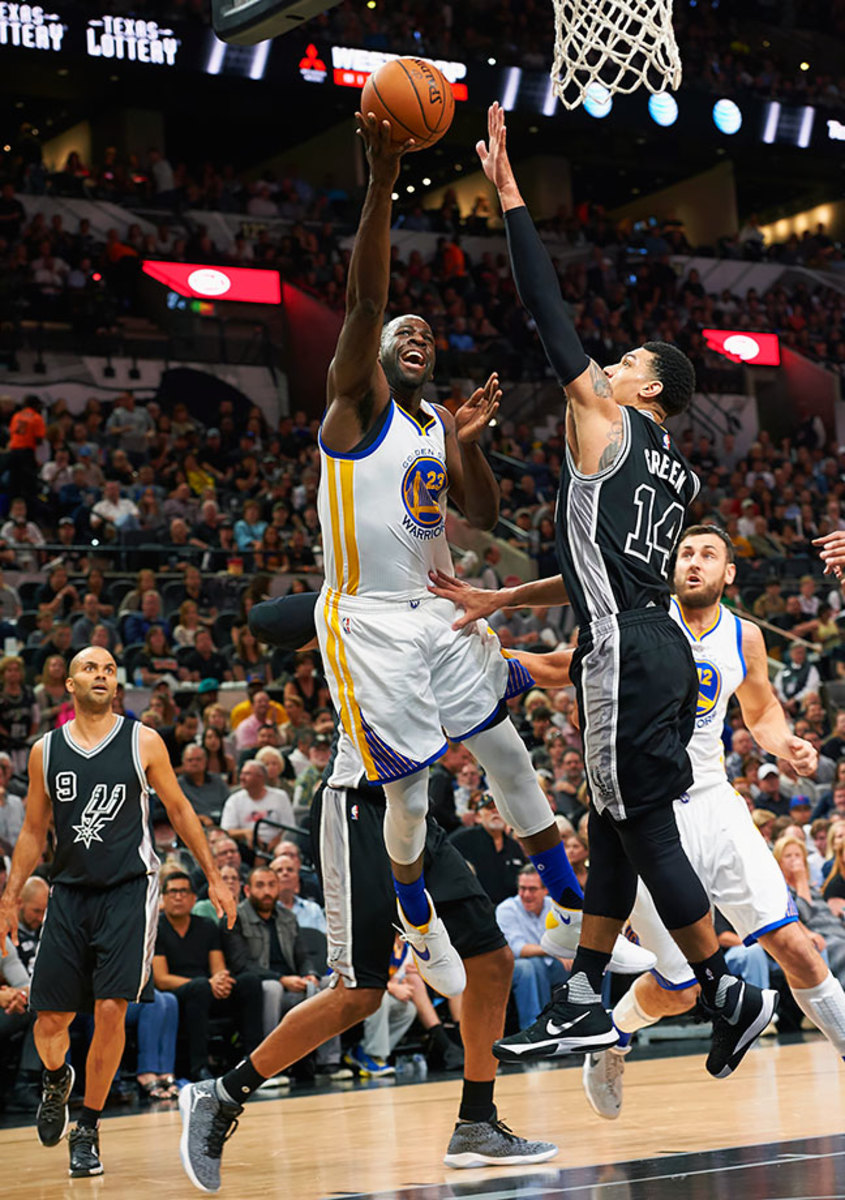
Draymond Green shoots against Danny Green during the game between the Golden State Warriors and San Antonio Spurs on April 10, 2016 at AT&T Center in San Antonio.
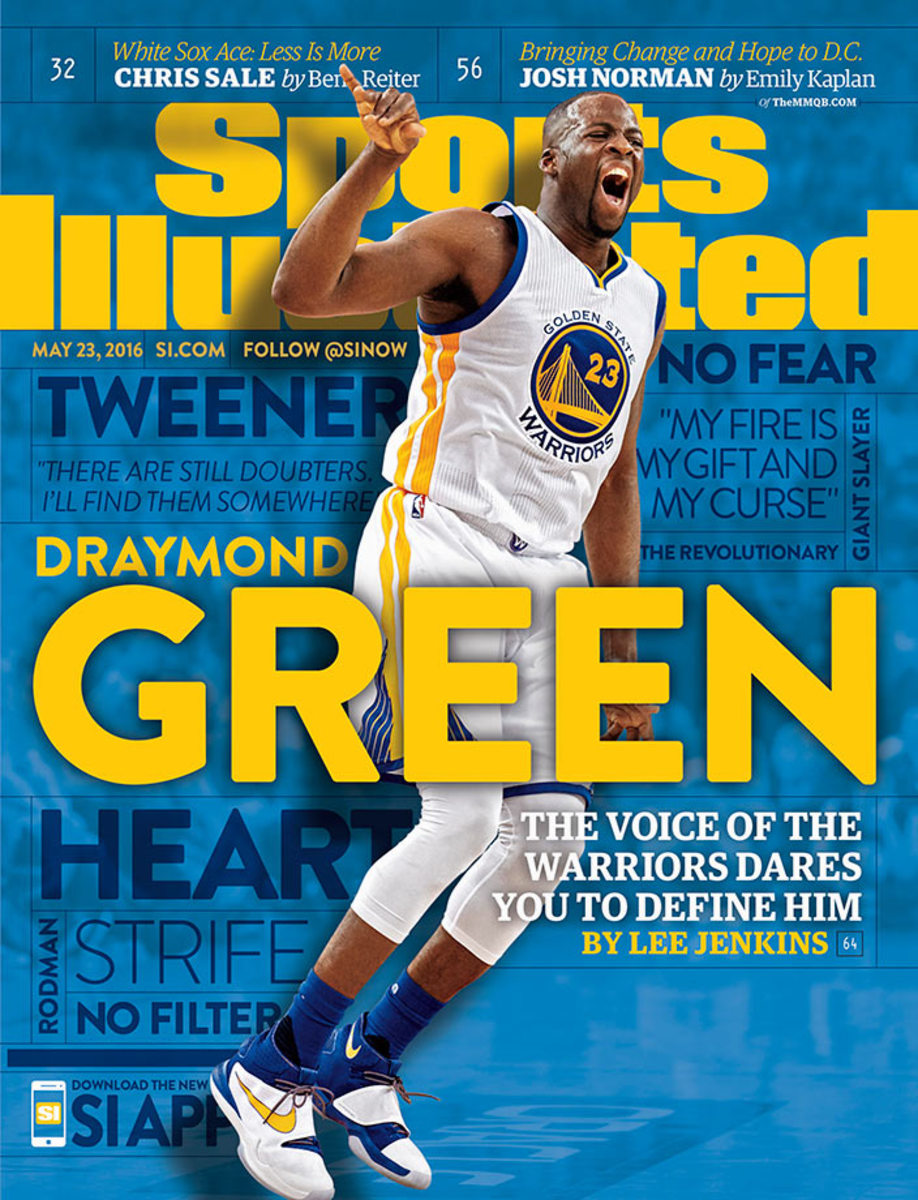
Draymond Green appears on the May 23, 2016 cover of Sports Illustrated.
Livingston does this well enough that roughly half of his field goals were assisted this season. Many ball handlers live in the 20–30% range, particularly if their teams lack supplemental playmakers. Golden State has no such problem; Draymond Green has assisted Livingston more times than any other Warrior this season, in part due to the way that the Warriors invert positional tradition and, by extension, their literal spacing on the floor. You can often find Livingston living along the baseline, operating in the same spaces that a power-finishing center might.
“We've made the game unorthodox,” Livingston said. “Spacing the court—it's not just us, it started with guys before, obviously: Phoenix, the Spurs, Miami. Teams have gone small. But I think defenses are designing themselves to play small now, and maybe leave one big guy in to play as a rim protector.”
That’s been the case through long stretches of the Western Conference finals, where Kevin Durant and Serge Ibaka have helped to maintain defensive order for OKC’s smaller lineups. Livingston has been challenged; the Thunder know to play him for his pull-up jumper and have the length to contest his runners. Golden State has been so out of sorts, too, that it really only started posting Livingston against smaller defenders in Game 5. There’s opportunity to do more of that as the Warriors seek out supplementary scoring options, and for Livingston to feel out his way to a handful of baskets and assists in every game. Look a step removed and you’ll find even more plays that he in some way establishes or facilitates.
Livingston just makes sense as a Warrior, even when he blends so seamlessly as to be inconspicuous. For as well as Livingston did as a fill-in starter, some of his finer stretches are relatively modest. Curry can stun viewers in ways that are impossible to ignore. Thompson catches fire in plain view. Livingston is the kind of guard who can pop in for four minutes at a crucial moment in an elimination game, make winning play after winning play, and exit with most fans none the wiser. It’s in part due to those minutes that the Warriors—and the series—returns to Oklahoma City. Livingston travels with them, but he’s already at home.
